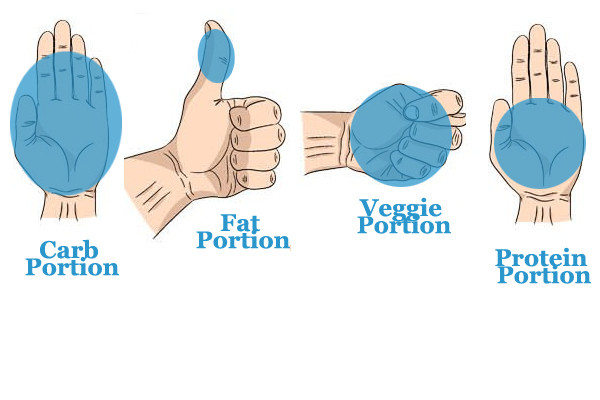
A different Way to Control Portions and Calories
Here is a simple method that helps build an awareness of what you are eating. It’s easy, it’s portable, and it’s scaled to the size of the person.
All you need are the ability to count to 2, and your own hand.
Here how it works:
- * Your palm determines your protein portions
- * Your fist determines your veggie portions
- * Your cupped hand determines your carb portions
- * Your thumb determines your fat portions
Of course, everybody is a little different. There’s not one “perfect” way of doing things, just as there’s not one “perfect diet” for everyone. But since bigger people tend to have bigger hands and smaller people have smaller hands, your own hand can be a personalized (and portable) measuring device for your food intake.
How Much Protein?
For protein-dense foods like meat, fish, eggs, cottage cheese and Greek yogurt, use a palm-sized serving. This means a serving has the same thickness and diameter as your palm. Each palm-sized serving provides approximately 20–30 grams of protein.
For men, six to eight palm-sized portions of protein each day. To simplify further, two palm-sized portions in each meal, assuming clients eat four meals per day.
For women, four to six palm-sized portions of protein each day. For simplicity, this works out to roughly one palm-sized portion in each meal (again, assuming four meals per day).
How Many Veggies?
For nonstarchy colorful vegetables (think broccoli, spinach, salad, carrots, etc.), use a fist-sized serving. Again, a fist-sized portion has the same thickness and diameter as your fist.
For men, we generally recommend six to eight fist-sized portions of vegetables each day. That comes out to roughly two fist-sized portions in each meal.
For women, we generally recommend four to six fist-sized portions of vegetables each day. This works out to roughly one fist-sized portion in each meal.
How Many Carbs? ?
For carbohydrate-dense foods—like grains, starches or fruits—use a cupped hand to determine your serving size. Each cupped handful provides approximately 20–30 g of carbohydrate.
For men, we generally recommend six to eight cupped handfuls of carbohydrate each day. This works out to roughly two cupped handfuls in each meal.
For women, we generally recommend four to six cupped handfuls of carbohydrate each day. This works out to roughly one cupped handful in each meal.
How Much Fat?
For fat-dense foods like oils, butters, nut butters and nuts/seeds, use your entire thumb to determine your serving size. A thumb-sized portion is the thickness and entire length of your thumb, and each serving provides approximately 7–12 g of fat.
For men, we generally recommend six to eight thumb-sized portions of fat each day. This works out to roughly two thumb-sized portions of fats in each meal.
For women, we generally recommend four to six thumb-sized portions of fat each day. This works out to roughly one thumb-sized portion in each meal.
This amount gives you enough fats to support the immune system, maintain sex hormones and perform many other vital functions without being excessive.
A Non Complicated Approach
Weight loss does not have to be complicated. You can become lean and healthy without following a prescribed meal plan, making yourself miserable in the gym or even counting calories.
That doesn’t mean it’s easy. Fat loss—like any life change—often requires trying new things, getting out of comfort zones and swapping old habits for new ones. And when it comes to food portions, size does matter. But you do NOT need a calculator, a scale or a calorie-counting app.
Call Steve, In-Training Sports | 561-281-8330
In Training Sports
www.intrainingsports.com
3131 Village Blvd, #305
West Palm Beach, FL 33409